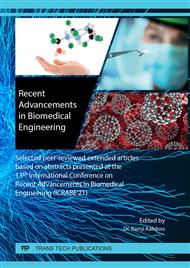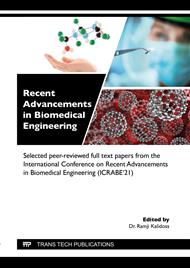[1]
J. Gao, M. Zhu, H. Huang, Y. Liu, and Z. Kang, Advances, challenges and promises of carbon dots, Inorg. Chem. Front., 4 (2017) 1963-1986.
DOI: 10.1039/c7qi00614d
Google Scholar
[2]
H. Li, Z. Kang, Z. Kang, Y. Liu, and S. T. Lee, Carbon nanodots: synthesis, properties and applications, J. Mater. Chem., 22 (2012) 24230-24253.
DOI: 10.1039/c2jm34690g
Google Scholar
[3]
K. Radhakrishanan, P. Panneerselvam, and S. Sivanesan, Fluorescence switching of green synthesized carbon dots@ g-C3N4nanosheet as a label-free sensor for detection of multiple metal ions," J PhotochemPhotobiol A.,389 (2020) 112204-112215.
Google Scholar
[4]
Y. Wang, and A. Hu, Carbon quantum dots: synthesis, properties and applications, J. Mater. Chem. C, 2 (2014) 6921-6939.
Google Scholar
[5]
M. Tuerhong, Y. Xub, X. B. Yin, Review on Carbon Dots and Their Applications, Chinese Journal of Analytical Chemistry, 45 (2017) 139-150.
DOI: 10.1016/s1872-2040(16)60990-8
Google Scholar
[6]
K. Radhakrishanan, P. Panneerselvam, and M. Marieeswaran, "Green Synthetic route for Surface-passivation of Carbon Dots as an Effective Multifunctional fluorescent sensor for Recognition of Toxic metal ions Detection from aqueous Solution. RSC, Anal Methods, 11, (2018) 490-506.
DOI: 10.1039/c8ay02451k
Google Scholar
[7]
Y. Park, J. Yoo, B. Lim, W. Kwon, and S. W. Ree, Improving the functionality of carbon nanodots: doping and surface functionalization J. Mater. Chem. A, 4 (2016) 11582-11603.
DOI: 10.1039/c6ta04813g
Google Scholar
[8]
K. Radhakrishanan, P. Panneerselvam, Green Synthesis of surface passivated Carbon Dots from Prickly Pear Cactus as a Fluorescent probe for Dual Detection of Arsenic (III) and Hypochlorite ions from Drinking water medium, RSC adv., 8, (2018) 30455-30467.
DOI: 10.1039/c8ra05861j
Google Scholar
[9]
X. H. Wang, K. G. Qu, B. L. Xu, J. S. Ren, X. G. Qu, Microwave assisted one-step green synthesis of cell-permeable multicolor photoluminescent carbon dots without surface passivation reagents. J Mater Chem, 21 (2011) 2445-2450.
DOI: 10.1039/c0jm02963g
Google Scholar
[10]
M. K. Barman, B. Jana, S. Bhattacharyya, A. Patra, Photophysical Properties of Doped Carbon Dots (N, P, and B) and Their Influence on Electron/Hole Transfer in Carbon Dots–Nickel (II) Phthalocyanine Conjugates, J. Phys. Chem. C., 118 (2014) 20034-20041.
DOI: 10.1021/jp507080c
Google Scholar
[11]
D. Bano, V. Kumar, V. K. Singh, and S. H. Hasan, Green synthesis of fluorescent carbon quantum dots for the detection of mercury (II) and glutathione, New Journal of Chemistry 42 (2018) 5814-5821.
DOI: 10.1039/c8nj00432c
Google Scholar
[12]
Z. A. I. Mazrad, K. Lee, A. Chae, I. In, H. Lee and S. Y. Park, Progress in internal/external stimuli responsive fluorescent carbon nanoparticles for theranostic and sensing applications, J. Mater. Chem. B, 6 (2018) 1149-1178.
DOI: 10.1039/c7tb03323k
Google Scholar
[13]
V. Sharma, P. Tiwari, and S. M. Mobin, Sustainable carbon-dots: recent advances in green carbon dots for sensing and bioimaging, J. Mater. Chem. B, 5 (2017) 8904-8924.
DOI: 10.1039/c7tb02484c
Google Scholar
[14]
V. Pushpa Rani, B. B. Pranesh Moorthy, K. Shanmuga Priya, A. Anitha Nancy, G. Meena Kumai, Phytochemical Screening and GC-MS Analysis in Wild Variety of Coccinia indica – An Future Promising Therapeutic Source, American Journal of Phytomedicine and Clinical Therapeutics, 4 (2016) 98-105.
Google Scholar



